Introduction – Does Yoga Help with Focus and Concentration? Top 7 Yogasanas to Sharpen Your Brain
In the fast-paced world we live in, maintaining focus and concentration is crucial for success in various aspects of life. While there are numerous strategies to enhance cognitive abilities, one practice that has gained significant attention is yoga. This ancient discipline not only promotes physical well-being but also holds the potential to sharpen the mind. In this article, we delve into the question: Does yoga help with focus and concentration? Moreover, we explore the top 7 yogasanas that can significantly contribute to enhancing brain function.
Table of Contents
Does Yoga Help with Focus and Concentration?

Of course Yes, yoga is known to be beneficial for focus and concentration.
- The practice of yoga involves a combination of physical postures, breath control (pranayama), and meditation, which collectively contribute to improving mental clarity and concentration.
- The mindfulness cultivated during yoga helps individuals become more aware of the present moment, Reducing distractions and Improving a focused mindset.
- Moreover, the controlled breathing techniques in yoga can have a calming effect on the nervous system, enhancing the ability to concentrate.
- Regular practice of yoga has been associated with improved cognitive function, making it a valuable tool for those seeking to enhance their focus and concentration.
The Connection Between Yoga and Mental Clarity
Yoga’s Mind-Body Connection
Yoga is not merely a physical exercise; it is a holistic practice that intertwines the mind and body. The conscious breathing, controlled movements, and meditation involved in yoga foster a deep connection between the physical and mental realms. This synchronization, often overlooked in conventional exercises, can lead to heightened mental clarity and focus.
Stress Reduction and Cognitive Performance
Stress, a common hindrance to concentration, is effectively addressed through yoga. The practice encourages relaxation and stress reduction through controlled breathing and mindfulness. As stress diminishes, cognitive performance improves, allowing individuals to concentrate more effectively on tasks at hand.
The Top 7 Yogasanas for Sharpening Your Brain
we’ll explore the top 7 yogasanas (yoga poses) specifically designed to elevate cognitive function and bring about a sharper, more focused mind.
Padmasana (Lotus Pose):
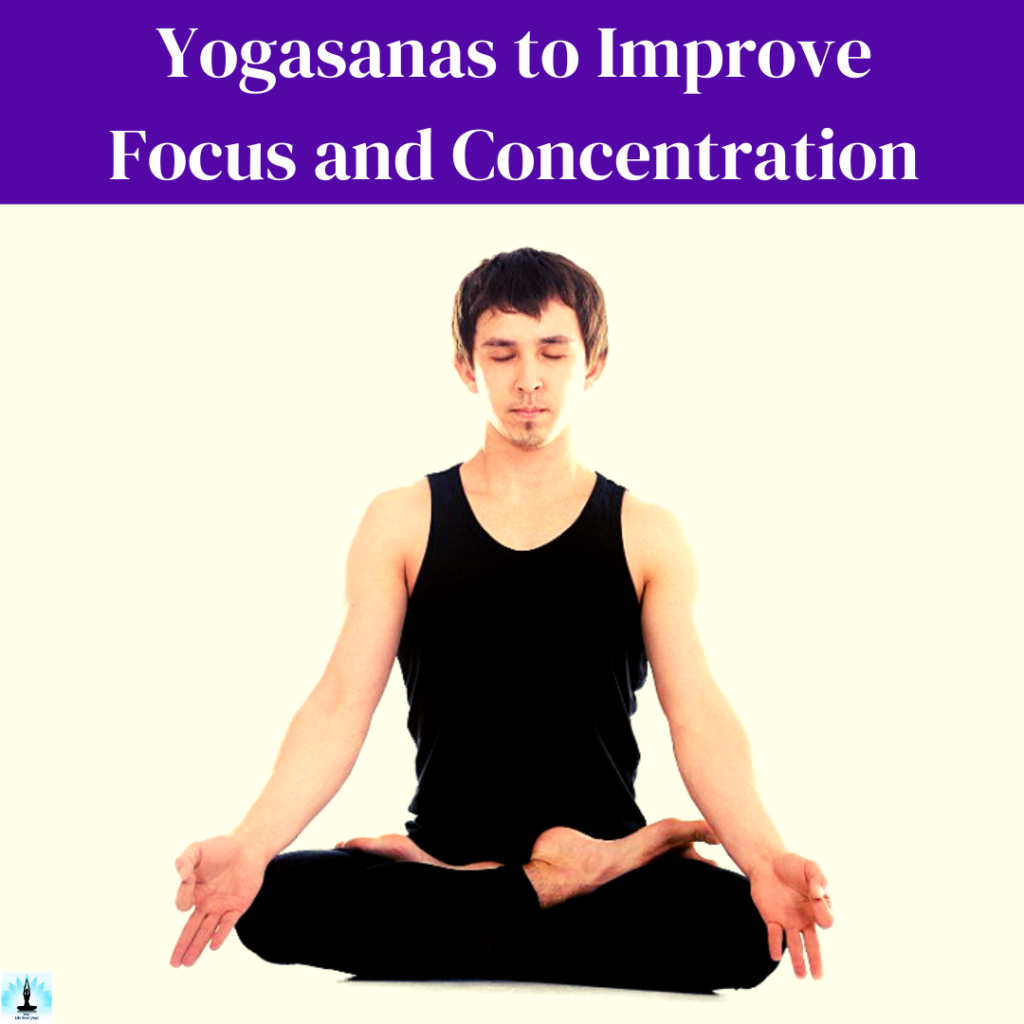
Padmasana, or the Lotus Pose, is a seated posture that holds immense significance in the realm of meditation and mental focus.
- Sit cross-legged with your spine straight.
- Place each foot on the opposite thigh, bringing the soles of the feet up.
- This pose helps in calming the mind and improving focus.By adopting this pose, practitioners align their body and mind, creating a conducive environment for concentration. The crossed-legged position helps maintain a straight spine, promoting a serene mental state.
Sarvangasana (Shoulder Stand):

Known as the Shoulder Stand, Sarvangasana involves lifting the entire body, with a particular emphasis on the shoulders and neck.
- Lie on your back and lift your legs and torso, supporting your back with your hands.
- This pose is thought to increase blood flow to the brain, promoting mental clarity and concentration.
- This inversion pose is believed to enhance blood circulation to the brain, fostering mental clarity and improving memory. It is often considered a powerful yogasana for stimulating the mind.
Paschimottanasana (Seated Forward Bend):
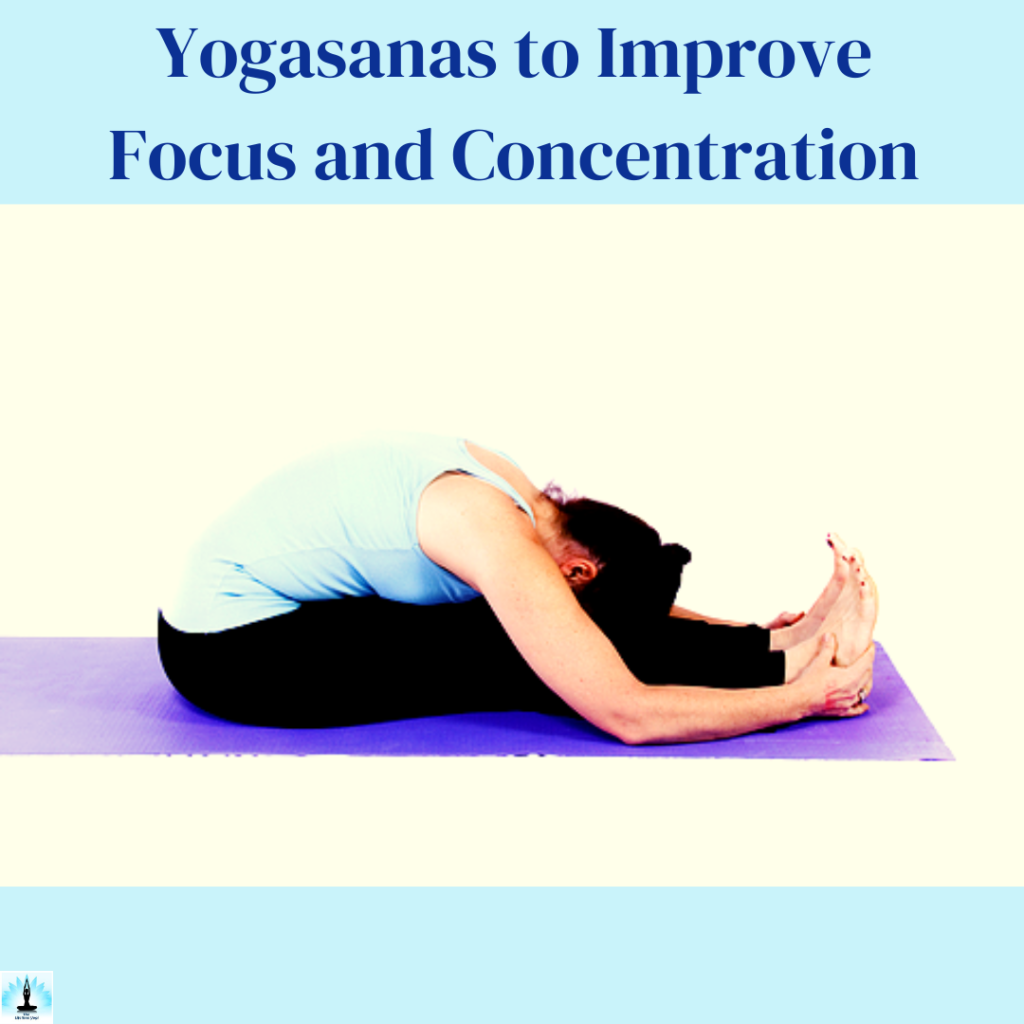
Paschimottanasana, or the Seated Forward Bend, encourages a forward stretch that engages the spine and stretches the entire back of the body.
- Sit with your legs extended and bend forward, reaching for your toes.
- This pose helps to relieve stress and enhances blood circulation to the brain, promoting mental calmness
- This pose is effective in relieving stress and calming the mind. The increased blood flow to the brain promotes relaxation and mental well-being.
Bhramari Pranayama (Bee Breath):
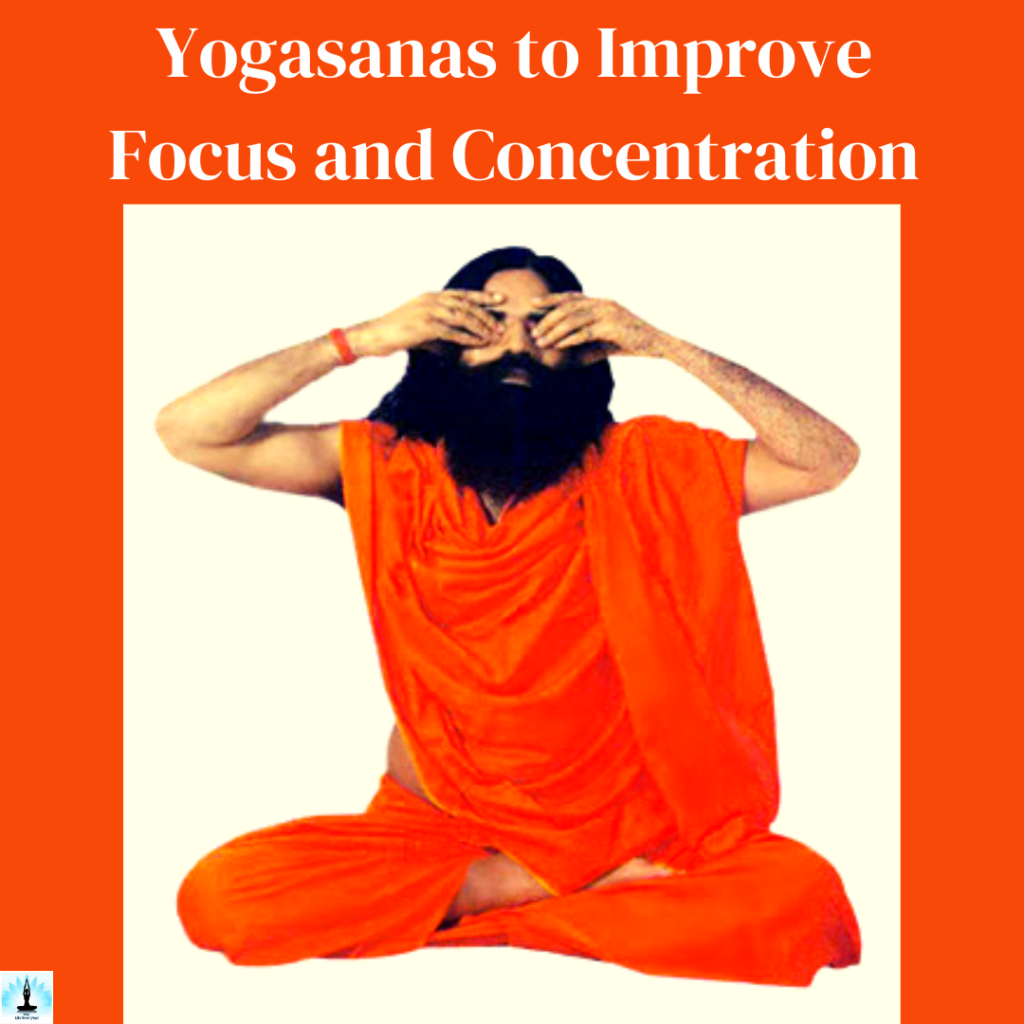
While not a physical asana, Bhramari Pranayama, or the Bee Breath, deserves mention for its impact on mental focus.
- Sit comfortably and take a deep breath.
- Exhale while making a humming sound like a bee.
- This breathing exercise is believed to calm the mind, reduce stress, and improve concentration.
- By creating a humming sound during exhalation, this breathing exercise helps calm the mind, reduce stress, and improve concentration. It’s a simple yet effective technique to bring about mental clarity.
Halasana (Plow Pose):
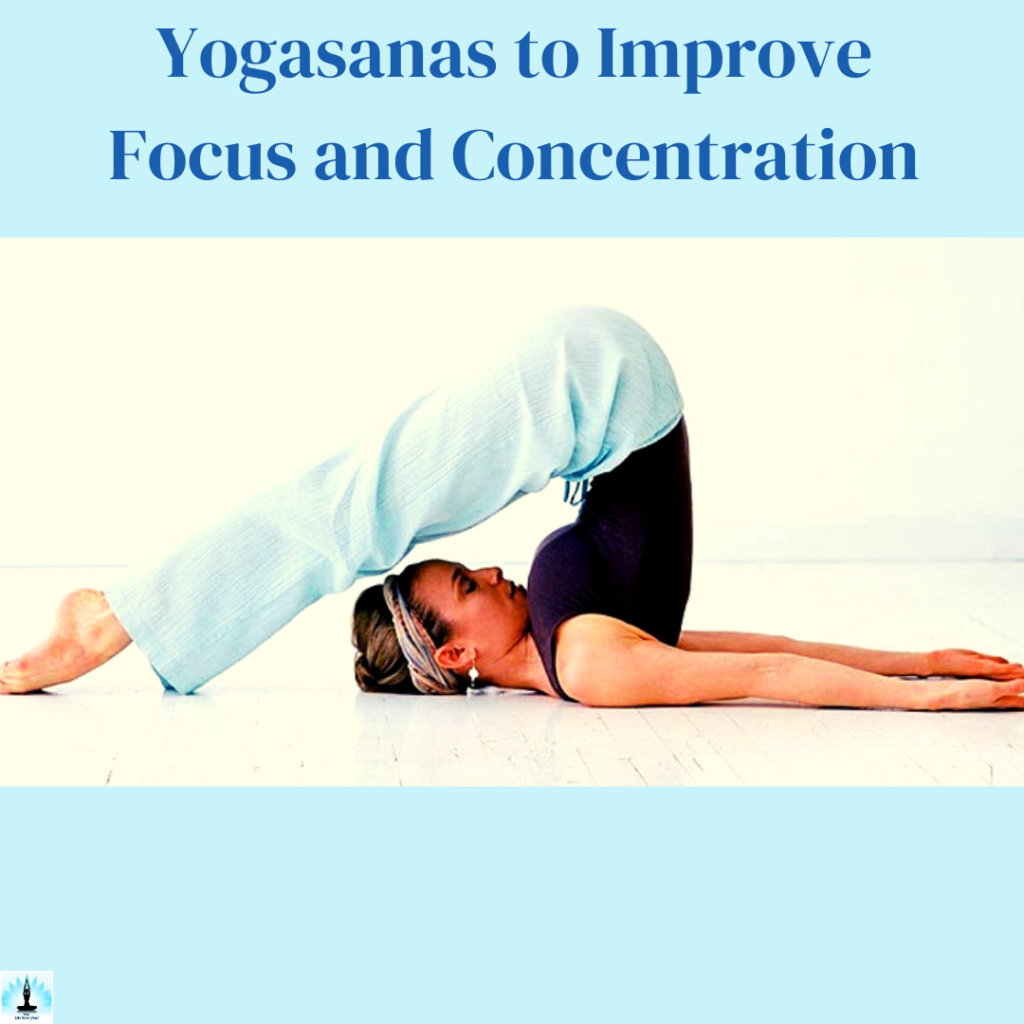
Halasana, the Plow Pose, involves a deep stretch of the spine and neck as the legs are lifted over the head.
- Lie on your back and lift your legs over your head, bringing them to the floor behind you.
- This pose is thought to stimulate the brain, reduce fatigue, and improve memory.
- This inversion pose is believed to stimulate the brain and reduce fatigue. Regular practice of Halasana may contribute to improved cognitive function and mental alertness.
Vrikshasana (Tree Pose):

Vrikshasana, or the Tree Pose, is a standing posture that demands focus, balance, and concentration.
- Stand on one leg and place the sole of the other foot on the inner thigh or calf.
- This pose helps in improving balance, focus, and concentration.
- By grounding one foot and placing the sole of the other foot on the inner thigh or calf, practitioners enhance their sense of balance and mental stability. This pose is excellent for improving concentration and mental focus.
Nadi Shodhana Pranayama (Alternate Nostril Breathing):
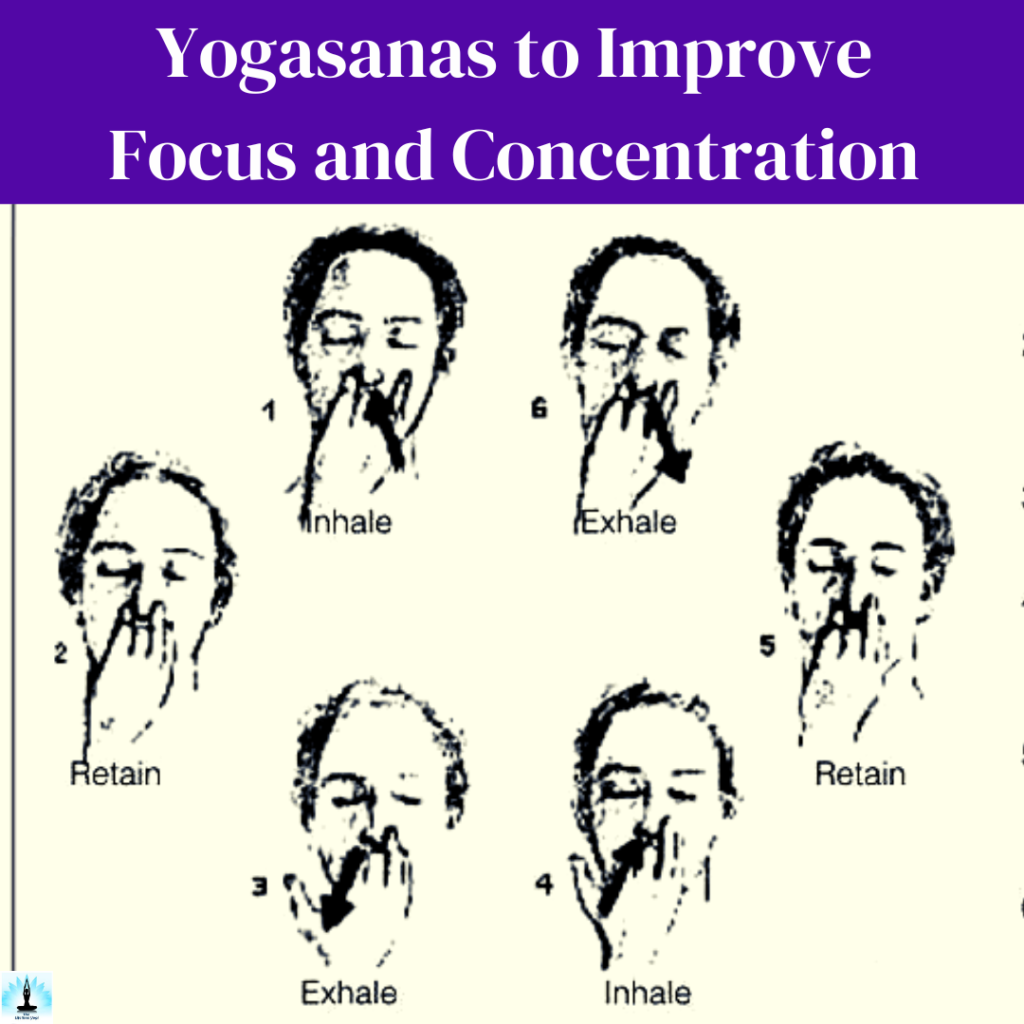
Nadi Shodhana Pranayama, or Alternate Nostril Breathing, is a breathing exercise that aims to balance the left and right hemispheres of the brain.
- Sit comfortably and use your thumb and ring finger to alternately close one nostril while breathing in and out.
- This pranayama technique is believed to balance the left and right hemispheres of the brain, promoting mental clarity.
- By alternating nostrils during inhalation and exhalation, practitioners create harmony in the brain, promoting mental clarity and improved cognitive function.
FAQs on “Does Yoga Help with Focus and Concentration? Top 7 Yogasanas to Sharpen Your Brain”
Which Yoga Is Best for Focus and Concentration?
A form of yoga known as Dharana, which emphasizes concentration and focus, is particularly effective for enhancing mental clarity. Dharana involves directing one’s attention to a single point, object, or thought, helping to train the mind for improved focus and concentration.
Which Yoga Is Best for Study?
For enhancing study sessions, Vinyasa yoga is beneficial. Vinyasa incorporates flowing movements synchronized with breath, promoting an active and alert state of mind. The dynamic nature of Vinyasa helps in maintaining energy levels during study sessions and can contribute to better information retention.
Which Yoga Is Best for Brain?
Kundalini yoga is often regarded as beneficial for overall brain health. It involves a combination of physical postures, breath control, and meditation, which can stimulate brain function and enhance cognitive abilities.
How To Increase Concentration by Practicing Yoga?
To boost concentration through yoga, regular practice of mindfulness-based yoga, such as Hatha yoga, can be effective. Hatha yoga involves slow-paced postures and conscious breathing, fostering a calm and focused mental state.
Which Pranayam Is Best for Brain?
Anulom Vilom, or alternate nostril breathing, is considered excellent for brain health. This pranayama technique helps balance the two hemispheres of the brain, enhancing cognitive function and concentration.
Does Yoga Sharpen Your Brain?
Yes, yoga has been shown to sharpen the brain by improving neural connections, increasing blood flow, and reducing stress. Regular practice of yoga has been associated with enhanced cognitive functions, including better memory and concentration.
Is Yoga Good for Studying?
Absolutely, yoga can be beneficial for studying. Practices like yoga asanas, pranayama, and meditation can reduce stress, improve focus, and increase energy levels, creating an optimal mindset for effective studying.
Can Yoga Improve IQ?
While yoga may not directly increase IQ, it can positively impact cognitive abilities and overall brain health. Regular yoga practice, especially styles that involve mindfulness and meditation, can contribute to improved cognitive function and mental clarity.
Why Do I Lack Focus?
Lack of focus can be attributed to various factors, including stress, fatigue, and a cluttered mind. Identifying the root cause, practicing mindfulness techniques, and incorporating concentration-focused yoga can help address this issue.
How Can I Fix My Lack of Concentration?
To address a lack of concentration, it’s crucial to establish a routine that includes regular breaks, proper sleep, and mindfulness practices like yoga. Incorporating concentration-enhancing yoga poses and meditation can also be effective.
How Can I Train My Mind to Focus?
Mindfulness meditation and concentration-focused yoga practices, such as Trataka (focused gazing), can help train the mind to focus. Consistent practice gradually improves concentration abilities.
Which Mudra Is Most Powerful for Brain?
The Gyana Mudra, or chin mudra, is considered powerful for the brain. This hand gesture involves touching the tip of the index finger to the tip of the thumb, enhancing concentration and promoting mental clarity.
Which Mudra Is Brain Exercise?
Prana Mudra is often referred to as a mudra for brain exercise. This mudra involves connecting the thumb with the ring and pinky fingers, promoting vitality and mental alertness.
What Is the Best Brain Exercise?
Meditation, particularly mindfulness meditation, is considered one of the best brain exercises. It enhances brain function, reduces stress, and improves overall cognitive abilities.
Can Yoga Control Overthinking?
Yes, yoga, especially mindfulness-based practices, can help control overthinking by promoting awareness of thoughts and providing techniques to manage and redirect the mind’s focus.
How Can I Increase My Memory Power and Concentration?
Regular practice of memory-enhancing yoga poses, such as Sarvangasana (shoulder stand), combined with meditation and pranayama, can contribute to increased memory power and concentration.
What Yoga Clears Your Mind?
Yoga practices that emphasize mindfulness and meditation, such as Mindful Hatha Yoga, are effective in clearing the mind. These practices encourage being present in the moment, reducing mental clutter.
How Do I Activate My Full Brain Power?
To activate full brain power, a holistic approach is needed. This includes regular physical exercise, a balanced diet, proper sleep, mindfulness practices like yoga and meditation, and engaging in activities that stimulate the mind.
Can Yoga Cure Brain Fog?
Yes, yoga can help lighten brain fog by reducing stress, improving blood circulation to the brain, and helping mental clarity. Practices like pranayama and meditation are particularly effective.
How Can I Activate My Brain More?
Combining activities that challenge the brain, such as learning new skills, combined with regular physical exercise and mindfulness practices like yoga, can help activate the brain more effectively.
How Can I Sharpen My Memory?
Practices like meditation, specifically mindfulness meditation, along with memory-enhancing yoga poses like Padmasana (lotus pose), can contribute to sharpening memory.
How Can I Increase My Brain Power To 100 Percent?
Claiming 100 percent brain power is a metaphor, optimizing brain health involves a combination of factors such as regular exercise, a balanced diet, sufficient sleep, mindfulness practices, and continuous mental stimulation.
How To Grow Intelligence?
Growing intelligence involves lifelong learning, staying mentally active, engaging in activities that challenge the mind, practicing mindfulness, and adopting a healthy lifestyle. Yoga, with its focus on both physical and mental well-being, can be a valuable component of this journey.
Conclusion
In conclusion, the correlation between yoga and improved focus and concentration is well-established. Incorporating specific yogasanas into your routine can be a transformative step towards sharpening your brain and achieving mental clarity. Whether you’re a seasoned yogi or a beginner, embracing these practices can contribute significantly to your overall well-being.
References
- “Bhagwat Geeta 4.29”. Bhagwat Geeta with commentaries of Ramanuja, Madhva, Shankara and others. 13 Sep 2012. Retrieved 10 May 2021.
- Mittra, Dharma (2003). Asanas: 608 Yoga Poses. ISBN 978-1-57731-402-8.
- Rhodes, Darren (2016). Yoga Resource Practice Manual. Tirtha Studios. ISBN 978-0-9836883-9-6.
- Samuel, Geoffrey (2017) [2008]. The Origins of Yoga and Tantra. Indic Religions to the Thirteenth Century. Cambridge University Press. ISBN 978-0521695343.
- Saraswati, Swami Satyananda (1996). Asana Pranayama Mudra Bandha (PDF). Yoga Publications Trust. ISBN 978-81-86336-14-4. Archived from the original (PDF) on 2015-08-07. Retrieved 2018-11-26.
- Shearer, Alistair (2020). The Story of Yoga: From Ancient India to the Modern West. London: Hurst Publishers. ISBN 978-1-78738-192-6.
- G. C. Pande, Foundations of Indian Culture: Spiritual Vision and Symbolic Forms in Ancient India. Second edition published by Motilal Banarsidass Publ., 1990, p. 97.
- Iyengar, B. K. S. (2011). Light on prāṇāyāma: the yogic art of breathing. New York: Crossroad. OCLC 809217248.
- Mallinson, James (2011). Knut A. Jacobsen; et al., eds. Haṭha Yoga in the Brill Encyclopedia of Hinduism, Vol. 3. Brill Academic. pp. 772-773. ISBN 978-90-04-27128-9.
- Mallinson, James (2012). “The Original Gorakṣaśataka”. In White, David Gordon (ed.). Yoga in Practice. Princeton: Princeton University Press. pp. 257–272.
